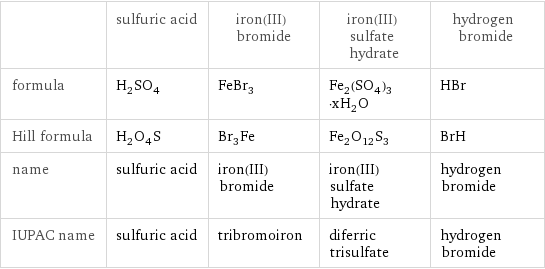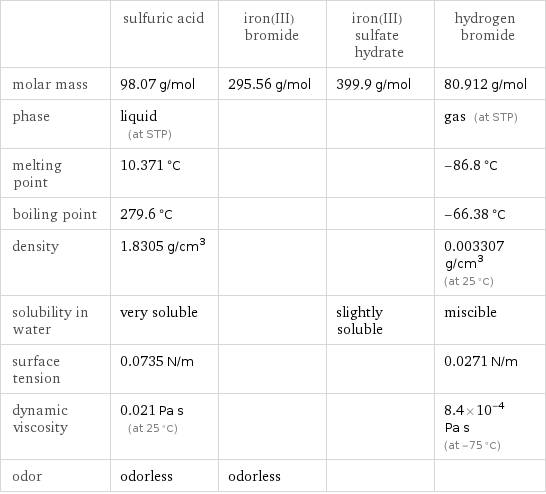Input interpretation

H_2SO_4 sulfuric acid + FeBr_3 iron(III) bromide ⟶ Fe_2(SO_4)_3·xH_2O iron(III) sulfate hydrate + HBr hydrogen bromide
Balanced equation

Balance the chemical equation algebraically: H_2SO_4 + FeBr_3 ⟶ Fe_2(SO_4)_3·xH_2O + HBr Add stoichiometric coefficients, c_i, to the reactants and products: c_1 H_2SO_4 + c_2 FeBr_3 ⟶ c_3 Fe_2(SO_4)_3·xH_2O + c_4 HBr Set the number of atoms in the reactants equal to the number of atoms in the products for H, O, S, Br and Fe: H: | 2 c_1 = c_4 O: | 4 c_1 = 12 c_3 S: | c_1 = 3 c_3 Br: | 3 c_2 = c_4 Fe: | c_2 = 2 c_3 Since the coefficients are relative quantities and underdetermined, choose a coefficient to set arbitrarily. To keep the coefficients small, the arbitrary value is ordinarily one. For instance, set c_3 = 1 and solve the system of equations for the remaining coefficients: c_1 = 3 c_2 = 2 c_3 = 1 c_4 = 6 Substitute the coefficients into the chemical reaction to obtain the balanced equation: Answer: | | 3 H_2SO_4 + 2 FeBr_3 ⟶ Fe_2(SO_4)_3·xH_2O + 6 HBr
Structures

+ ⟶ +
Names

sulfuric acid + iron(III) bromide ⟶ iron(III) sulfate hydrate + hydrogen bromide
Equilibrium constant
![Construct the equilibrium constant, K, expression for: H_2SO_4 + FeBr_3 ⟶ Fe_2(SO_4)_3·xH_2O + HBr Plan: • Balance the chemical equation. • Determine the stoichiometric numbers. • Assemble the activity expression for each chemical species. • Use the activity expressions to build the equilibrium constant expression. Write the balanced chemical equation: 3 H_2SO_4 + 2 FeBr_3 ⟶ Fe_2(SO_4)_3·xH_2O + 6 HBr Assign stoichiometric numbers, ν_i, using the stoichiometric coefficients, c_i, from the balanced chemical equation in the following manner: ν_i = -c_i for reactants and ν_i = c_i for products: chemical species | c_i | ν_i H_2SO_4 | 3 | -3 FeBr_3 | 2 | -2 Fe_2(SO_4)_3·xH_2O | 1 | 1 HBr | 6 | 6 Assemble the activity expressions accounting for the state of matter and ν_i: chemical species | c_i | ν_i | activity expression H_2SO_4 | 3 | -3 | ([H2SO4])^(-3) FeBr_3 | 2 | -2 | ([FeBr3])^(-2) Fe_2(SO_4)_3·xH_2O | 1 | 1 | [Fe2(SO4)3·xH2O] HBr | 6 | 6 | ([HBr])^6 The equilibrium constant symbol in the concentration basis is: K_c Mulitply the activity expressions to arrive at the K_c expression: Answer: | | K_c = ([H2SO4])^(-3) ([FeBr3])^(-2) [Fe2(SO4)3·xH2O] ([HBr])^6 = ([Fe2(SO4)3·xH2O] ([HBr])^6)/(([H2SO4])^3 ([FeBr3])^2)](../image_source/eb5d7616b4717c17324aa966b2d2eed6.png)
Construct the equilibrium constant, K, expression for: H_2SO_4 + FeBr_3 ⟶ Fe_2(SO_4)_3·xH_2O + HBr Plan: • Balance the chemical equation. • Determine the stoichiometric numbers. • Assemble the activity expression for each chemical species. • Use the activity expressions to build the equilibrium constant expression. Write the balanced chemical equation: 3 H_2SO_4 + 2 FeBr_3 ⟶ Fe_2(SO_4)_3·xH_2O + 6 HBr Assign stoichiometric numbers, ν_i, using the stoichiometric coefficients, c_i, from the balanced chemical equation in the following manner: ν_i = -c_i for reactants and ν_i = c_i for products: chemical species | c_i | ν_i H_2SO_4 | 3 | -3 FeBr_3 | 2 | -2 Fe_2(SO_4)_3·xH_2O | 1 | 1 HBr | 6 | 6 Assemble the activity expressions accounting for the state of matter and ν_i: chemical species | c_i | ν_i | activity expression H_2SO_4 | 3 | -3 | ([H2SO4])^(-3) FeBr_3 | 2 | -2 | ([FeBr3])^(-2) Fe_2(SO_4)_3·xH_2O | 1 | 1 | [Fe2(SO4)3·xH2O] HBr | 6 | 6 | ([HBr])^6 The equilibrium constant symbol in the concentration basis is: K_c Mulitply the activity expressions to arrive at the K_c expression: Answer: | | K_c = ([H2SO4])^(-3) ([FeBr3])^(-2) [Fe2(SO4)3·xH2O] ([HBr])^6 = ([Fe2(SO4)3·xH2O] ([HBr])^6)/(([H2SO4])^3 ([FeBr3])^2)
Rate of reaction
![Construct the rate of reaction expression for: H_2SO_4 + FeBr_3 ⟶ Fe_2(SO_4)_3·xH_2O + HBr Plan: • Balance the chemical equation. • Determine the stoichiometric numbers. • Assemble the rate term for each chemical species. • Write the rate of reaction expression. Write the balanced chemical equation: 3 H_2SO_4 + 2 FeBr_3 ⟶ Fe_2(SO_4)_3·xH_2O + 6 HBr Assign stoichiometric numbers, ν_i, using the stoichiometric coefficients, c_i, from the balanced chemical equation in the following manner: ν_i = -c_i for reactants and ν_i = c_i for products: chemical species | c_i | ν_i H_2SO_4 | 3 | -3 FeBr_3 | 2 | -2 Fe_2(SO_4)_3·xH_2O | 1 | 1 HBr | 6 | 6 The rate term for each chemical species, B_i, is 1/ν_i(Δ[B_i])/(Δt) where [B_i] is the amount concentration and t is time: chemical species | c_i | ν_i | rate term H_2SO_4 | 3 | -3 | -1/3 (Δ[H2SO4])/(Δt) FeBr_3 | 2 | -2 | -1/2 (Δ[FeBr3])/(Δt) Fe_2(SO_4)_3·xH_2O | 1 | 1 | (Δ[Fe2(SO4)3·xH2O])/(Δt) HBr | 6 | 6 | 1/6 (Δ[HBr])/(Δt) (for infinitesimal rate of change, replace Δ with d) Set the rate terms equal to each other to arrive at the rate expression: Answer: | | rate = -1/3 (Δ[H2SO4])/(Δt) = -1/2 (Δ[FeBr3])/(Δt) = (Δ[Fe2(SO4)3·xH2O])/(Δt) = 1/6 (Δ[HBr])/(Δt) (assuming constant volume and no accumulation of intermediates or side products)](../image_source/f2776c146c0184e84ddc2e4f37a83b46.png)
Construct the rate of reaction expression for: H_2SO_4 + FeBr_3 ⟶ Fe_2(SO_4)_3·xH_2O + HBr Plan: • Balance the chemical equation. • Determine the stoichiometric numbers. • Assemble the rate term for each chemical species. • Write the rate of reaction expression. Write the balanced chemical equation: 3 H_2SO_4 + 2 FeBr_3 ⟶ Fe_2(SO_4)_3·xH_2O + 6 HBr Assign stoichiometric numbers, ν_i, using the stoichiometric coefficients, c_i, from the balanced chemical equation in the following manner: ν_i = -c_i for reactants and ν_i = c_i for products: chemical species | c_i | ν_i H_2SO_4 | 3 | -3 FeBr_3 | 2 | -2 Fe_2(SO_4)_3·xH_2O | 1 | 1 HBr | 6 | 6 The rate term for each chemical species, B_i, is 1/ν_i(Δ[B_i])/(Δt) where [B_i] is the amount concentration and t is time: chemical species | c_i | ν_i | rate term H_2SO_4 | 3 | -3 | -1/3 (Δ[H2SO4])/(Δt) FeBr_3 | 2 | -2 | -1/2 (Δ[FeBr3])/(Δt) Fe_2(SO_4)_3·xH_2O | 1 | 1 | (Δ[Fe2(SO4)3·xH2O])/(Δt) HBr | 6 | 6 | 1/6 (Δ[HBr])/(Δt) (for infinitesimal rate of change, replace Δ with d) Set the rate terms equal to each other to arrive at the rate expression: Answer: | | rate = -1/3 (Δ[H2SO4])/(Δt) = -1/2 (Δ[FeBr3])/(Δt) = (Δ[Fe2(SO4)3·xH2O])/(Δt) = 1/6 (Δ[HBr])/(Δt) (assuming constant volume and no accumulation of intermediates or side products)
Chemical names and formulas

| sulfuric acid | iron(III) bromide | iron(III) sulfate hydrate | hydrogen bromide formula | H_2SO_4 | FeBr_3 | Fe_2(SO_4)_3·xH_2O | HBr Hill formula | H_2O_4S | Br_3Fe | Fe_2O_12S_3 | BrH name | sulfuric acid | iron(III) bromide | iron(III) sulfate hydrate | hydrogen bromide IUPAC name | sulfuric acid | tribromoiron | diferric trisulfate | hydrogen bromide
Substance properties

| sulfuric acid | iron(III) bromide | iron(III) sulfate hydrate | hydrogen bromide molar mass | 98.07 g/mol | 295.56 g/mol | 399.9 g/mol | 80.912 g/mol phase | liquid (at STP) | | | gas (at STP) melting point | 10.371 °C | | | -86.8 °C boiling point | 279.6 °C | | | -66.38 °C density | 1.8305 g/cm^3 | | | 0.003307 g/cm^3 (at 25 °C) solubility in water | very soluble | | slightly soluble | miscible surface tension | 0.0735 N/m | | | 0.0271 N/m dynamic viscosity | 0.021 Pa s (at 25 °C) | | | 8.4×10^-4 Pa s (at -75 °C) odor | odorless | odorless | |
Units
